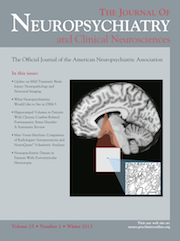Does Tardive Dysmentia Really Exist?
Abstract
Tardive dysmentia has been described as the behavioral equivalent of tardive dyskinesia in patients with schizophrenia. Its association with tardive dyskinesia and psychopathology has been controversial. The authors assessed 123 inpatients with chronic schizophrenia for presence of tardive dysmentia symptoms/signs. Psychopathology and tardive dyskinesia were also assessed. Of the group, 24 patients (19.5%) had at least one tardive dysmentia symptom/sign, whereas only 1 patient (0.8%) fulfilled the syndromal criteria for tardive dysmentia. Those with tardive dysmentia had higher psychopathology scores, higher Abnormal Involuntary Movement Scale total scores, higher number of women and family psychiatric illness, and higher rates of persistent tardive dyskinesia. Tardive dysmentia symptoms/signs are frequently seen in chronic schizophrenia, but the complete syndrome may be rare.



